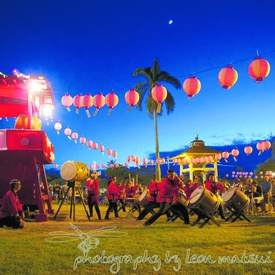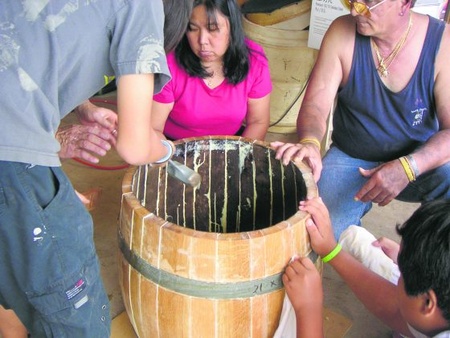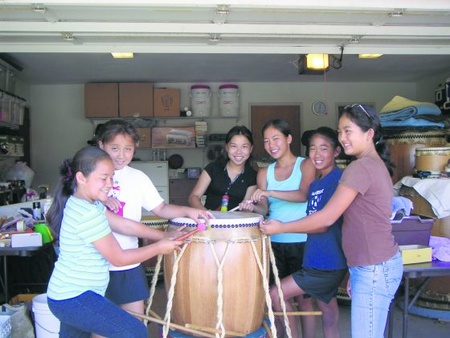Kay Fukumoto of Maui Taiko is the embodiment of a treasured legacy that continues to resonate today, despite the ravages of a global pandemic and the devastating loss of a beloved family member — her sister Lin Watanabe. Perhaps Fukumoto’s admirable resilience can be partly attributed to being the first female (at age 10) to be allowed to play the highly revered taiko. According to Fukumoto, at that time, if a taiko player did not meet expectations the player was expelled from the yagura (tower).
“I’m continuing the tradition of Fukushima Ondo on Maui, and it’s being done through Maui Taiko, which is a 25-year-old organization,” Fukumoto explained. “However, this tradition on Maui has been in existence for over a century,” she added, “and the first group started at the Keahua Sugar Plantation Camp. It was created by descendants of Fukushima. That group of men pooled their money together and bought the supplies to make the yagura and bought the taiko.”
When the Keahua Sugar Plantation Camp closed, they donated the yagura and taiko to the Paia Mantokuji Mission, said Fukumoto. Her father Albert Watanabe, grandfather Tomio Watanabe, grandmother Chie Watanabe, and great grandfather Tomijiro Watanabe are an integral part of the treasured legacy of Maui Taiko. “My sister and I continued it along with my husband Ronald,” Fukumoto said, “and my son Mitchell who is in Santa Clara sort of took Fukushima Ondo to the mainland and introduced the songs there. My involvement with Maui Taiko has been for more than 15 years.”
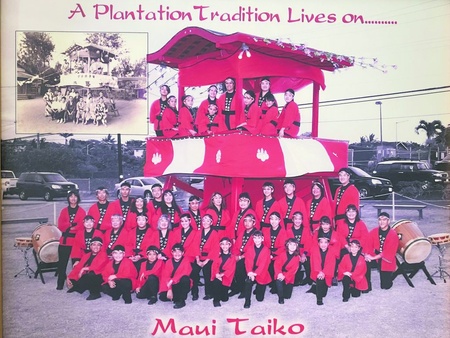
Originally, Fukushima Ondo was done only during Obon season, primarily at Paia Mantokuji Mission. When Fukumoto formed Maui Taiko, the organization introduced as well as performed songs at all the various temples on Maui – including several elderly care facilities. “We restarted the Hana Obon couple of years ago,” Fukumoto noted. “We are entrenched in continuing the tradition of performing the songs. Back in the day, we normally rehearsed a couple of months before Obon.”
According to Fukumoto, a couple of members of that group moved to O‘ahu (Honolulu, specifically). She noted that the Fukushima Ondo on O‘ahu is comprised of some groups that trace back to the Maui Fukushima Ondo. When the shutdown in Hawai‘i occurred as a result of the global pandemic, the tradition was suspended. For Maui Taiko, it’s not just a matter of playing a song, Fukumoto explained. Rather, Fukumoto added, it’s about Maui Taiko’s connection to ancestors and remembering them every year.
“It’s what our ancestors did for us, so we can have our beautiful lives now,” Fukumoto said,“and in terms of whenever a tradition ends, even for a short period of time, there is a lot of reflection.” During the pandemic, Fukumoto lost her sister. “She was my younger sister. It was really tough to think that we couldn’t have Obon, because that’s what it’s all about, family being able to remember their loved ones and so we had a temple Obon.”
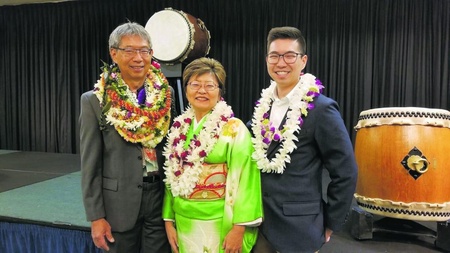
Maui Taiko assisted with creating the annual Maui Taiko Festival. During the pandemic, Maui Taiko was supposed to be celebrating its 20th anniversary but it was delayed. The festival is tied to the Obon season, so it excites people to engage in Obon events and traditional don happi coats. Fukumoto noted that Maui Taiko performed an Obon segment in November 2021. “We had a revised festival because we couldn’t do what we normally would do,” she explained. “It was done in a mall (Queen Ka’ahumanu Center) and we were able to do Obon at least for 2021.”
For 2022 there were three Obon events that were canceled, according to Fukumoto. She is hopeful that the temples will be able to hold Obon, as temples require everyone to wear a mask and practice social distancing, as well as hand sanitizing. And everyone is being mindful, Fukumoto noted. “We’re trying to honor our ancestors but at the same time remain healthy,” she explained. “It’s a delicate balance, because a lot of temple members are from the older generation, and each temple makes sure that they are mindful of safety.”
Separate from Fukushima Ondo, Maui Taiko is a performing group that presents many performances in the community. Fukumoto explained that during the pandemic, it was difficult to rehearse because the group’s main rehearsal site was a county facility (Kahului Community Center Annex) that was closed for two years. So Maui Taiko held online classes as well as meetings at a park, she noted. “It took some creative thinking,” Fukumoto said. “We knew that as soon as things opened up, we would be performing again.”
It’s Maui Taiko’s responsibility to give back to the community, according to Fukumoto. For Fukumoto and the Maui Taiko entourage, to participate in events that can bring the community together after being in lockdown during the pandemic is refreshing. “We’re really excited about performing again.”
Over the years, Maui Taiko has made most of their drums out of used red wine barrels from California. Fukumoto’s husband is an engineer so one benefit is that he ensures that the drums are perfectly crafted. Many of Maui Taiko’s drums have weathered the test of time, considering they are made of wine barrels. “Several of the drums are 20 years old,” Fukumoto said. “Because we’re connected to Fukushima and the Fukushima Prefecture, after the triple disasters we traveled to Fukushima and we presented seven performances within the region.”
Maui Taiko is connected to the film “Great Grandfather’s Drum,” which is about the Japanese Americans in Hawai‘i, Fukumoto explained, “and what they sacrificed as well as the history of that generation.” She noted that many people in Fukushima saw the message in this film of survival and perseverance through meeting and overcoming challenges. “It’s connected to Maui Taiko in a sense that through the struggles our ancestors faced, we still treasure and preserve our cultural connection through Japanese culture,” she said.
Fukumoto pointed out that “my family has hosted many students from Japan. And the ones that come to Hawai‘i, many of them have never been to Obon, and have never worn a yukata. So they are amazed that we have continued these traditions. I had a chance to lecture at a college in Tokyo. We had a drum that was transcribed in Japanese, so this professor in Japan shot the film, and I was going to travel in Japan. I came to a class and we had a discussion and many of them said that they had moved from the countryside to the city, and had not returned to their hometown for Obon.”
In Japan, Obon is usually held during one weekend, said Fukumoto. “And so it’s like a national holiday when people return to their hometown,” she explained. “But a lot of them had not done that, and they felt that I was more Japanese than they were. And that year I did that, they all said they will return to their hometown, after seeing the film. This is something they had not thought about. And here was an American who comes to Japan to enlighten them.”
Maui Taiko performed a year after the devastation in Japan at a Fukushima taiko festival, Fukumoto recalled. “We were invited to perform there and were, I think, 15 groups that performed. I invited them to come to Maui. About 30 people came to Maui the following year. One of the 30 people was a gentleman, Hisakatsu Yokoyama, who donated a taiko body to us. It was made out of kiaki, which is similar to koa. Very rare. He gave it to us because he couldn’t return to his home in Fukushima because of high levels of radiation. We built the taiko and the following year, he and his two friends came over and put the last nail into the taiko before we skinned the taiko. And the next evening we used that taiko at the Paia Mantokuji Soto Mission.”
The next year Fukumoto invited the gentleman and his two friends to come to Maui and Maui Taiko would learn their town songs for them to keep the town songs alive on Maui. In hopes that one day when their town reopens, Maui Taiko can take the taiko as well as the music back to their towns. “It’s interesting how things happen for a reason,” Fukumoto noted. “It started with us going to Japan and to Fukushima after the triple disaster, and then someone gifting us the taiko as well as music, so we need to preserve these precious memories.”
Fukumoto expressed cautious optimism for 2022, with Obon events as well as scheduled performances. “We’re hopeful that we can return to some sort of normalcy,” she said. “During the pandemic I was thinking a lot about the internment of Japanese Americans. When the internment occurred, people had to get rid of their family heirlooms and strip themselves of their identity. It’s important that we preserve our identity as well as our treasured culture. Hopefully, through the efforts of Maui Taiko, there’s a resurgence of commitment to the Obon traditions.”
* This article was originally published in The Hawaii Herald on July 15, 2022.
© 2022 George Furukawa




